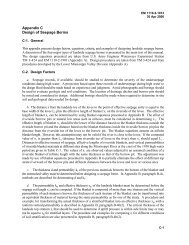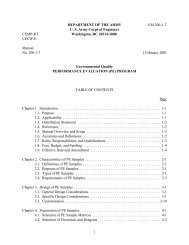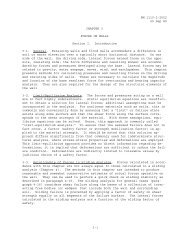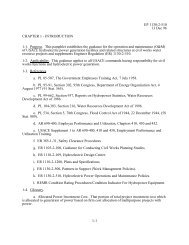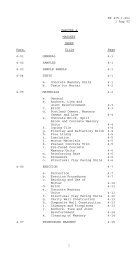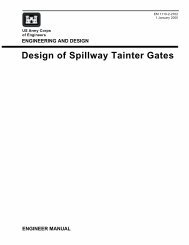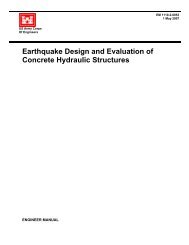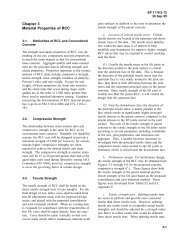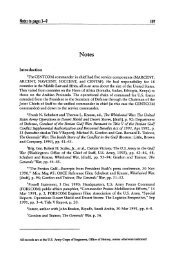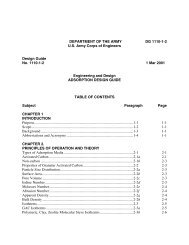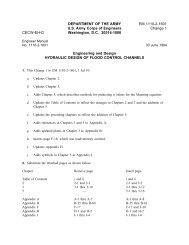Chapter 5 - Publications, US Army Corps of Engineers
Chapter 5 - Publications, US Army Corps of Engineers
Chapter 5 - Publications, US Army Corps of Engineers
Create successful ePaper yourself
Turn your PDF publications into a flip-book with our unique Google optimized e-Paper software.
EM 1110-2-1701<br />
31 Dec 1985<br />
record SSR routings to estimate annual energy output and dependable<br />
capacity (see Section 7-6).<br />
(7) &stem Studies. Where a project is operated as a part <strong>of</strong> a<br />
system, SSR analysis is required to properly model the impact <strong>of</strong><br />
system operation on that project’s power output. The only case where<br />
the flow-duration or hybrid method might be used would be in the<br />
examination <strong>of</strong> a single existing project with no power storage, where<br />
an adequate historical record exists, no changes in project operation<br />
are expected, and no changes in streamflow resulting from the<br />
regulation <strong>of</strong> upstream projects are expected.<br />
5-5. ine Character~<br />
a. &ner& Certain turbine characteristics, such as efficiency,<br />
usable head range, and minimum discharge, can have an effect on<br />
a hydro project’s energy output. For preliminary ~wer studies, it is<br />
usually sufficient to use a fixed efficiency value and ignore the<br />
minimum discharge constraint and possible head range limitations.<br />
However, for a feasibility level study, these characteristics should<br />
be accounted for in cases where they would have a significant impact<br />
on the results. This section presents some general information on the<br />
turbine characteristics required for making power studies and on the<br />
operating parameters involved in the selection <strong>of</strong> a specific turbine<br />
design.<br />
(1) A variety <strong>of</strong> turbine types are available, each <strong>of</strong> which is<br />
designed to operate in a particular head and flow range. Figure 2-35<br />
illustrates the normal operating ranges for each type. In addition, a<br />
specific turbine is capable <strong>of</strong> operating within a limited head range.<br />
A horizontal Kaplan unit, for example, has a ratio <strong>of</strong> maximum head to<br />
minimum head <strong>of</strong> about 3 to 1. Table 5-1 (Section 5-6i) describes the<br />
usable operating head range for each <strong>of</strong> the major turbine types.<br />
(2) Where possible, a runner design is selected such that the<br />
turbine can operate satisfactorily over the entire range <strong>of</strong> expected<br />
heads. This is especially important in the case <strong>of</strong> storage projects,<br />
where drawdown characteristics may be a major factor in selection <strong>of</strong><br />
the type <strong>of</strong> turbine to be installed. At storage projects with a wide<br />
head range, it is sometimes possible to utilize interchangeable<br />
runners in order to ❑aintain generation over the full head range.<br />
(3) When adding power facilities to projects not originally<br />
designed for power operation, head ranges may exceed the capabilities<br />
<strong>of</strong> any turbine type. Examples are (a) low head projects where the<br />
5-1o




